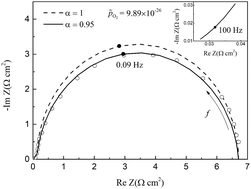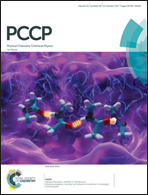Modeling the impedance spectra of mixed conducting thin films with exposed and embedded current collectors†
Abstract
In this article, we develop a new finite-element-based model for the simulation of the electrochemical impedance spectroscopy (EIS) response of mixed ionic electronic conducting (MIEC) thin films. We first validated the model against experimental data for Sm-doped CeO2 (SDC) symmetrical films deposited on an yittria-stabilized ZrO2 (YSZ) substrate, a pure ionic conductor. We first studied the configuration where the patterned electrodes are placed on top of the MIEC (“exposed” configuration). Our model is capable of correctly reproducing the EIS response and the total capacitance, together with their dependence on the oxygen partial pressure. Furthermore, we were able to show, in agreement with experiments, that the area specific resistance (Rp) is relatively insensitive to the density of triple phase boundaries. As a second step, we studied the configuration where the metal current collector is directly deposited on the ionic conductor and is, therefore, “embedded” into the MIEC. We were again able to reproduce the experimental EIS response. We also discovered that at sufficiently high frequencies, the EIS deviates from a traditional RC-type response, leading to features attributable to the coupling ionic and electronic transport. This coupling ultimately adds to the area specific resistance. The latter, however, can be minimized if the film is sufficiently thick or if the current collector configuration is chosen judiciously.



 Please wait while we load your content...
Please wait while we load your content...